Study Context
As an increased number of refugee crises become measured in years instead of months, programmatic focus has shifted from emergency response towards recovery and durable solutions. Refugees are highly vulnerable, highly mobile populations, and as a result, are often difficult to find and keep in touch with. But without long-term follow up, it is impossible to accurately measure migration trends and understand the effectiveness of programs aimed at improving refugee wellbeing over time.
Study Design
The Syrian Refugee Life Study (S-RLS) uses a randomized control trial to evaluate the effectiveness of NRC Jordan’s Urban Shelter Program, which pairs rental subsidies to Syrian refugees with physical repairs to the structure they rent. This evaluation estimates the direct and spillover effects of this shelter assistance on beneficiaries, their children, and their host communities. In addition to this novel randomized evaluation, S-RLS is also undertaking long-term longitudinal data collection in one of the first systematic efforts to survey a large, representative refugee sample and follow that sample over time. In addition to capturing economic outcomes (consumption, assets, earnings, savings and credit), the survey measures migration history, education, marriage, fertility, physical and mental health, social attitudes, behaviors, and preferences.
Results and Policy Lessons
Longitudinal Panel Results Summary
Demographic Outcomes: Syrian headed households are found to be larger than Jordanian headed households. On average, Syrian households have 5.96 members while non-refugee Jordanian households have 4.61 members. While the Syrian refugee population has a similar gender distribution as the Jordanian population, the refugee population is on average younger than the non-refugee Jordanian population.
Health Outcomes: Data from our most recent survey (2022) indicates that 58% of Syrian refugees in Jordan likely suffer from depression. Furthermore, children of depressed parents are assessed to have worse socio-emotional outcomes than other children on average.
Social Outcomes: The vast majority of S-RLS respondents do not intend to return to Syria before the conflict is resolved (91%), which is something that few believe is likely in the next two years (< 20%). Fifty-seven percent of respondents would like to stay in Jordan after the Syrian conflict ends. Syrian and Jordanian children are fairly interactive with one another: 48% of Syrian children are said to have Jordanian friends, and 45% share recreational spaces with Jordanian kids.
All future S-RLS data, code, and materials will be made publicly available on Harvard Dataverse. Currently, data and materials from the in-person 2020 partial survey round are available on the database. This open source public good is a highly beneficial tool made available to the research community at large. For more information, please contact Sarah Stillman at sstillman@berkeley.edu
Results from additional rounds of our panel and from our shelter impact evaluation forthcoming.






